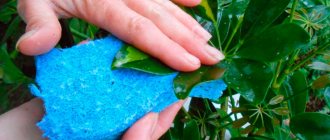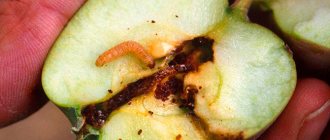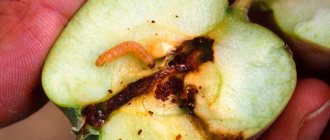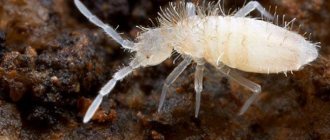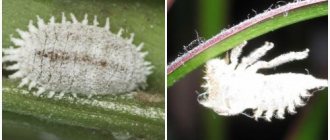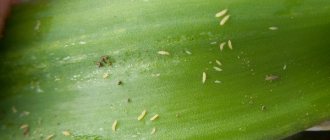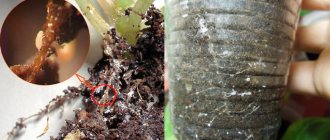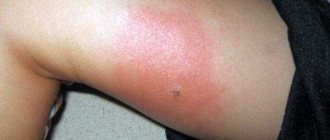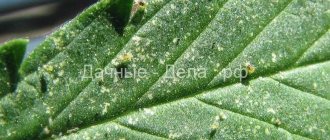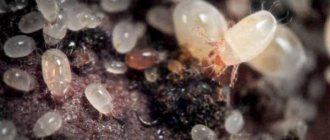Whitefly - everything you need to know
The whitefly is an insect from the aphid family. Causes serious damage to plants by sucking sap. It is not difficult to discover that the whitefly has settled on indoor plants (the photo will simplify the task) by itself and is actively laying eggs. To do this, just touch the infected crop - white small midges will surround it with a dense cloud.
Female whiteflies reproduce by laying eggs away from direct sunlight, preferably on the underside of leaves. The larvae cannot fly, so they spend most of their time motionless, gradually becoming covered with a white coating. Under the influence of the pest, parts of the plant change shape, lose color and fall off over time.
In addition, the insect is a carrier of infections.
The most vulnerable to whitefly are delicate indoor plants:
In indoor conditions, the insect is capable of infecting these plants throughout the year, flying from one to another around the apartment or house.
Types of whiteflies on indoor plants
Not all known species of whiteflies can harm indoor plants. Most often, the following varieties live in houses:
- Greenhouse (greenhouse) whitefly . A very heat-loving species from the tropics, which can only live in greenhouses and houses .
- Cotton (tobacco) whitefly . An almost omnivorous pest, it loves humid heat. In such conditions, it can give birth to up to 14-16 generations per year .
- Giant whitefly . A real scourge of ornamental plants. The larvae differ from other species by the presence of long stripes of wax on them.
- Citrus whitefly . Prefers to feed on citrus plants, can harm gardenias , cherry laurel , hibiscus and ficus .
Whitefly at home - reasons for its appearance
To understand how to get rid of whiteflies on indoor flowers, you should study the characteristics of the pests and start with the reasons for their appearance in the house. Understanding what prompted them to settle on flowers will help prevent future infestations.
As a rule, the main reasons for the appearance of dangerous white midges in an apartment are:
- Failure to comply with temperature and humidity conditions.
- Inability to ventilate the room.
- High plant density.
- Infection through newly acquired plants.
High plant density provokes the appearance of pests.
The dangerous whitefly, paradoxically, is also very gentle. It dies if the temperature drops below 15 degrees, and its subsequent appearance becomes impossible.
Appearance of insects
Whiteflies are very small, even tiny butterflies that resemble house moths. The length of the largest individual does not exceed 4 mm. They got their name because of their snow-white wings, as if sprinkled with starch. It's actually a wax coating.
The body is painted pale yellow and is also covered with a waxy coating. The head has long antennae and compound eyes.
The eggs are microscopic in size , practically invisible, their length is only 0.1-0.2 mm . They are attached to the plant using a stem.
The larvae do not have wings ; they have a flat oval body, reaching 0.8-0.9 mm in length. The skin, which is initially transparent, becomes covered with a white waxy coating with age.
Next you will see a photo of whiteflies on indoor flowers:
Creating optimal conditions for pest control
When deciding to fight whitefly on indoor flowers, you need to be prepared for the fact that the process will not be quick and simple. Insects can be removed in several stages, observing certain conditions to prepare for the “war”.
They start with quarantine for infected plants. To prevent the spread of the insect, infected plants are separated from healthy ones and placed in a room with the lowest possible temperature.
If we are talking about flowers that are unpretentious to the cold, such as fuchsia, then the most suitable place for it would be a window sill on an open balcony in late autumn or early winter, when the temperature reaches the desired level. A week will be enough for the white butterflies to die completely.
After the mass extermination of the pest by temperatures, the remains of eggs and traces of adult individuals are washed off with water, and the soil in the pot is replaced with new one. Damaged parts of the plant are removed in order to prevent the formation of putrefactive cells.
Below are several ways to combat whiteflies if the freezing method is not suitable for some reason. For greater efficiency and taking into account the latest generation of larvae covered with a wax shell, several methods will need to be combined to achieve results.
Signs of infection
The pest appears in a greenhouse or house unnoticed. There are many ways he can do this.
Determining if there is a problem
If you need to decide how to deal with whiteflies, then first establish that there is a problem. Small flying insects above flowers will be a cause for concern. It is worth considering the following criteria if you need to fight whiteflies:
- translucent scales under the leaf (pest larvae);
- sticky coating with shine (the result of the body’s vital activity);
- waste products of sooty fungus;
- insufficient growth of leaves and stems;
- yellowness of the surface of all parts of the flower body;
- leaf curling.
If you have recorded at least one of the above symptoms, then you need to take measures to combat whiteflies on indoor plants immediately in order to preserve your favorite flowers.
Signs of plant infection
- The bush slows down its development, the foliage turns yellow and begins to fall off. There is a clear growth retardation.
- If you turn the leaf plate over, a sticky shiny coating is visible. This is honeydew, a waste product of an insect.
- On the reverse side of the leaf you can see accumulations of larvae and eggs in the form of translucent small scales.
- If you touch a bush, small flies fly up above it.
- The appearance of whitish spots on the leaf plate. Later they turn black. This is the development of sooty fungus, which most often accompanies honeydew.
These signs indicate that a dangerous pest has appeared in the house. It is omnivorous, so it settles on any indoor plants. However, there are flowers that he especially loves. These are begonia, fuchsia, violets, hydrangea. He also likes young seedlings, especially tomatoes, cabbage, and cucumbers. They must be carefully inspected regularly.
Where do white-winged flies come from in an apartment?
- Purchasing infected plants from a greenhouse or store. Butterflies and larvae, especially if there are few of them, are difficult to notice on the leaves.
- In the warm season, a moth may fly into a vent or window. The mosquito net is not a problem for him, since he is very small.
- Transfer with contaminated soil. The eggs tolerate wintering well in the soil. In the spring, when they get warm, they transform into larvae. After which they look for a power source and continue development.
At first, it is difficult to notice the settlement of white-winged flies. The problem becomes obvious at the stage of significant pest spread. The more there are, the more difficult it is to fight them. There are a number of signs indicating that it’s time to think about how to get rid of whiteflies on indoor flowers and seedlings.
Causes of the pest
The main feature of whiteflies is their ability to move from one plant to another with lightning speed, and also to spoil the leaves and stems of flowers in a short period of time. Such pests lay eggs on the outside of leaves.
Experts call the most important and key reasons for the appearance of whiteflies:
- High humidity in the room.
If the room humidity is constant within 50% - 60%, then this is an excellent breeding ground for such pests.
- Temperature above 25 - 26 degrees.
Whiteflies are heat-loving insects. They do not adapt well to the cold and rarely start if the temperature in the apartment is below 23 - 22 degrees Celsius.
- Irregular wiping of leaves, as well as untimely removal of curled or dried leaves.
Since these pests lay eggs on the leaves, when no one inspects or wipes the plants, the insects actively reproduce.
- Ignoring recommendations for taking a number of preventive measures. For example, the room where flowers grow is poorly ventilated, there is not enough lighting, etc.
Also, the insect may appear in the house along with new indoor flowers that were brought from the store or from friends.
Risk factors and breeding season of organisms
The question of how to deal with whiteflies in the garden mainly arises among summer residents during the warm rainy season. A humid environment in summer is optimal for the development and reproduction of the insect. An important question is at what temperature the whitefly dies and how long it takes for it to produce offspring. Pests stop functioning at a temperature of -10 degrees Hg. The eggs are not exposed to toxic substances and can ensure the development of the population in the new season.
Follow simple rules for performing work in your dacha as preventive measures:
- do not create too dense beds;
- create conditions for ventilation of plantings;
- eliminate extermination measures during the rainy season;
- apply complex fertilizers;
- use biological stimulants as means to improve plant health.
The question of how to deal with whiteflies also arises among owners of greenhouses and greenhouses. In such places, the butterfly can continue to live even out of season.
Physical impact on whiteflies - what does it come down to?
A proven remedy for whiteflies is mechanical traps. With their help, you can get rid of adult individuals capable of flying. You can make a trap with your own hands from scrap materials.
For a simple sample you will need small plywood sheets or sheets of cardboard. They must be painted in a color that attracts insects (white or yellow), lubricated with castor oil and a mixture of honey and rosin. Baits are placed near the insect habitat. For example, if they settled on fuchsia, then the bait is placed right there - on the windowsill.
As an option for a whitefly trap, simple fly tapes, fixed near the infected plants, are also suitable.
Harm from whiteflies
The white-winged borer harms more than 200 plant species. It likes to breed and feed in warm places with high humidity. The pest's favorite habitat is considered to be greenhouses, greenhouses and remote abandoned places in gardens, which receive the least attention.
The whitefly loves to feed on agricultural plants. You can expect it to appear in fields and gardens where potatoes, eggplants, cucumbers, legumes and pumpkins grow. The insect pays special attention to delicate plants, such as flowers of geraniums, orchids and violets.
Chemicals against pests - which ones to choose?
If white midges on geraniums or fuchsias have proliferated so much that traps do not save the situation, it is worth moving on to more radical methods of control - using chemicals.
As mentioned above, a proven remedy against whiteflies is Aktara. It is used to treat the soil of plants infected with insects with accompanying spraying. You can increase the effectiveness of the drug by using it together with Actellik. Following the instructions, Actellik solution is used to spray indoor flowers.
A noticeable effect can be achieved by using Tanrek against the white pest. The result obtained in this case will last for at least three weeks, even at high temperatures.
Fitoverm has also proven itself well as a biological insecticide that is not capable of harming plants or humans. Along with it, benzyl benzoate emulsion, Fury, Mospilan, Intavir, Thiazipir and other drugs can be used.
For those who are going to use the drug Actellik or any of the above, the recommendation of adding shampoo or laundry soap to the solution may seem useful. In this case, the effect of the substances will be longer due to adhesion to the surface of the plants.
How to fight a pest using traditional methods?
Homemade decoctions and infusions also give a certain effect when you need to get rid of whiteflies on indoor plants. Compared to chemical drugs, such products are considered safer and more affordable. You can prepare the following types of drugs at home to fight with folk remedies:
- Tincture of yarrow herb (pour boiling water for a day, cool and use for spraying).
- Tincture of wormwood (dry herb is poured with boiling water for several hours, cooled and the plant is treated).
- A solution of laundry soap diluted in water for treating infected indoor flowers.
- A tincture of dandelion roots and leaves for spraying at intervals of several weeks.
- A tincture of dry citrus peels with a small addition of laundry soap.
- Garlic tincture for spraying.
All of the above remedies will help if white midges on fuchsia have not yet reached the scale where it is impossible to cope without chemicals.
Whitefly on fuchsia
Harmful butterflies are very fond of delicate fuchsia. To avoid losing the plant, measures should be taken immediately. First of all, you need to take the flower to a cool room where the temperature does not rise above 14-16° . Fuchsia can easily withstand regime changes, unlike heat-loving whiteflies.
To consolidate the result and finally survive the pests, place a trap next to the pot and treat the flower with insecticides.
Whiteflies are flying pests that can cause serious damage to plants. However, they can be dealt with quite well. And the sooner you start the fight, the greater the chances of a good result.
And if you have whiteflies on your indoor plants, the video will tell you how to fight them. Enjoy watching!
Biological methods - what are they?
If actara (you can read how to plant on the packaging) seems too risky, it’s worth trying a biological effect that is more friendly to plant health. For domestic plants, this method of control will be justified only if the flowers are grown in large quantities.
We are talking about the resettlement of a small rider. It is called encarsia and is released into crops at the beginning of the breeding season of the whitefly pest.
This is a predator that pierces the pest larva in order to suck out the lymph and gain vitality.
Packages of ready-made encarsia eggs can be easily purchased at specialized sales points. It is worth remembering that the predator attacks only the greenhouse whitefly and is powerless against tobacco and citrus fruits.
What kind of midges live in indoor flowers?
Various insects can live in pots with plants. If you understand what pest you are facing, the fight will be more effective.
Black midges
These are sciarids, which are also called fungus gnats. They are very small in size, literally a few millimeters. The body is elongated, gray-black, the wings are transparent.
Adult insects are not at all dangerous. Plants are threatened by eggs that sciarids lay in moist soil.
The hatched larvae are approximately 3–5 mm long. They have a black head and a white body. They feed on organic matter rotting in the ground, but can also gnaw thin young roots of plants.
White midges
They are also called whiteflies or aleurods. Adults are approximately 2–3 mm long. Outwardly, they resemble a moth. They have two pairs of milky white wings covered with a flour-like coating.
Gary Chang
Insects lay light-colored and clearly visible eggs on the underside of leaves. With special pleasure - on the juicy ones. These are found, for example, in fuchsias, primroses, pelargoniums, poinsettias, hibiscus, and abutilons.
Hatched larvae, like adult whiteflies, suck juices from stems and leaves. Damaged areas are deformed, curled, and sticky dew appears on them. If measures are not taken, the plant will die.
Drosophila
These are fruit flies 2–3 mm long. Outwardly, they resemble ordinary flies, only very miniature.
Katja Schulz
Drosophila are not dangerous to the plant. They are more likely to annoy people, as they quickly multiply and scatter around the apartment.
How to recognize a whitefly?
Recognizing a whitefly is not at all difficult. This insect looks like a small butterfly, a few millimeters in size. The pest looks like a moth, has elongated white wings that resemble flower petals.
If you notice small butterflies flying near plants in your garden or greenhouse, you should definitely inspect the bushes in the area.
When exploring the area, pay attention to the following signs:
- is there a flock of moths when shaking the plants;
- the plants are healthy or their stems begin to dry out and the leaves lag behind in development;
- are there any white new growths (moth larvae) on the outside of the leaf?
- whether honeydew (liquid secreted by the whitefly during feeding) has appeared on the leaves of the plants.
Since the butterfly is very tiny in size, many older gardeners do not notice it at first. This insect reproduces quickly and produces up to 15 generations during the year, so the fight against the problem most often begins only when the summer resident notices huge swarms of pests when moving the plant.
The whitefly butterfly is considered a harmful insect
How to get rid of black midges using improvised means
Start fighting black midges as soon as possible. And with both adults and larvae.
Carefully inspect the soil in the pot. If there are a lot of larvae in it, do not take risks and simply replant the plant in new soil.
Cluster of black midge larvae
If there are few larvae, treat the soil using one of the methods listed above.
Potassium permangantsovka
Instead of regular water, water the plant 1-2 times with a light pink solution of potassium permanganate.
Matches
Take a few matches and insert their heads into the ground near the edge of the pot, away from the flower itself.
After the second watering, the matches can be removed: all the sulfur has been washed away from them. If the larvae survive, repeat the procedure.
Repellent scents
Place a piece of orange peel or a clove of garlic on the soil in the pot. Just remember to replace the scent after a couple of days to prevent rotting.
Preventing the appearance of whiteflies
Like any living organism, the whitefly prefers comfortable living conditions (high air humidity and temperatures above 10C). Preventive measures to combat whiteflies are aimed at creating conditions under which the pest will die, leave your garden bed, greenhouse, room, or will not be able to reproduce and develop. It should be taken into account that the adult and its larvae die at temperatures close to zero degrees, but the laid eggs feel comfortable at much lower temperatures.
- Remove fallen leaves and stems in a timely manner - they contain the largest number of insect larvae and eggs;
- Regularly disinfect the soil under the plant. As a rule, whitefly offspring are found in the upper balls of soil;
- Monitor the air humidity in the house; do not water the plants before the top layer of soil dries out;
- Do not allow your pets' plantings to become thicker. Your flowers and ornamental plants should be well ventilated; open the windows from time to time or take them outside;
- Apply fertilizers in a timely manner, special attention should be paid to a sufficient amount of minerals such as potassium and phosphorus;
- Disinfect the equipment you use to work with your green spaces, keep your gloves clean;
- When planting plants of roses, fuchsias, violets and other flowers in tubs, check them for the presence of whitefly larvae and eggs and destroy them if found;
- For prevention purposes, place whitefly traps. They can be made from colored paper or polycarbonate (preferably yellow or blue) and coated with an adhesive substance; some gardeners use petroleum jelly (Photo). Also, similar traps can be purchased in specialized stores. In their reviews, gardeners and gardeners recommend hanging glue traps Pheromone, Bona Forte, ARGUS.
How to get rid of white midges using improvised means
Before starting treatment, inspect the plant. Immediately remove leaves that are heavily damaged and almost completely occupied by insects and their larvae.
If there are not very many insects, eggs and larvae, you can destroy them in the following ways:
Garlic infusion
Grind 2-3 cloves of garlic using a grater or knife. Fill with a liter of water at room temperature. Leave for a day in a dark place, and then strain and spray the plant.
How to get rid of fruit flies using improvised means
Traps
Take a plastic glass, deep bowl or jar. Place pieces of any ripe fruit at the bottom or pour in apple cider vinegar, compote or sweet wine. Add a couple of drops of liquid dishwashing detergent.
Cover the top with cling film and make holes in it with a large needle or toothpick.
Place the trap next to the pot in which the fruit flies have settled.
Strong odors
Light an aroma lamp with lemon and lime, patchouli and ylang-ylang oils next to the plants.
And if you are not afraid of the garlic aroma, put one clove in the pot.
How to get rid of midges using special means
You can buy them in hardware stores or departments with indoor flowers.
Sticky traps
Take fly tape or a sticky insect trap and place it near the affected plant. It will help get rid of flying individuals. This method is good if there are few insects.
Aerosols
Aerosols from flying insects will help destroy adult individuals that have just appeared on plants. When spraying, pay special attention to shelves, racks and window sills where potted plants stand.
After treatment, carry out wet cleaning.
Mosquito fumigators
Every day, plug the device into an outlet that is located near plants affected by pests. This will repel flying midges.
Systemic insecticides
Treat the plant with an insecticide containing thiamethoxam or imidacloprid. Strictly according to the manufacturer's instructions. This will help in the fight against white and black midges, but it will not save you from fruit flies.
Remember: insects can develop immunity to a certain drug. So it is better to alternate insecticides.
Signs of plant damage by whitefly
It is very easy to spot a plant affected by the pest. Stopping receiving the required amount of nutrients, the plant begins to dry out. It weakens, the leaves begin to curl, and the stem withers. Leaves may also lose their usual color and turn light green or yellow. Larvae live on the underside of the leaf and spread the bacteria in their feces.
The appearance of sooty fungi on the plant further worsens the situation. A plant affected by butterflies becomes covered with a sticky dark coating, which prevents it from receiving enough sun and sprouting new shoots. All this prevents the plant from going through all stages of development, from youth to aging, and leads to loss of yield and early death.
Why do midges appear in flowers?
To avoid the reappearance of insects, try to figure out where they came from.
Improper watering
Constantly waterlogged soil creates ideal conditions for insects. Drosophila can even settle in a swampy pan.
Stagnant air
Pests feel best and actively reproduce in rarely ventilated rooms without ventilation systems.
Uncultivated land
Midges can be brought in along with the soil. Moreover, both store-bought and collected at the dacha or in the forest.
External factors
Midges may well fly into an open window or window and enter an apartment along with bouquets or potted flowers.
Fungus gnats often enter rooms through hoods and ventilation shafts from warm and humid basements.
